
- 阻害剤
- 研究分野別
- PI3K/Akt/mTOR
- Epigenetics
- Methylation
- Immunology & Inflammation
- Protein Tyrosine Kinase
- Angiogenesis
- Apoptosis
- Autophagy
- ER stress & UPR
- JAK/STAT
- MAPK
- Cytoskeletal Signaling
- Cell Cycle
- TGF-beta/Smad
- 化合物ライブラリー
- Popular Compound Libraries
- Customize Library
- Clinical and FDA-approved Related
- Bioactive Compound Libraries
- Inhibitor Related
- Natural Product Related
- Metabolism Related
- Cell Death Related
- By Signaling Pathway
- By Disease
- Anti-infection and Antiviral Related
- Neuronal and Immunology Related
- Fragment and Covalent Related
- FDA-approved Drug Library
- FDA-approved & Passed Phase I Drug Library
- Preclinical/Clinical Compound Library
- Bioactive Compound Library-I
- Bioactive Compound Library-II
- Kinase Inhibitor Library
- Express-Pick Library
- Natural Product Library
- Human Endogenous Metabolite Compound Library
- Alkaloid Compound LibraryNew
- Angiogenesis Related compound Library
- Anti-Aging Compound Library
- Anti-alzheimer Disease Compound Library
- Antibiotics compound Library
- Anti-cancer Compound Library
- Anti-cancer Compound Library-Ⅱ
- Anti-cancer Metabolism Compound Library
- Anti-Cardiovascular Disease Compound Library
- Anti-diabetic Compound Library
- Anti-infection Compound Library
- Antioxidant Compound Library
- Anti-parasitic Compound Library
- Antiviral Compound Library
- Apoptosis Compound Library
- Autophagy Compound Library
- Calcium Channel Blocker LibraryNew
- Cambridge Cancer Compound Library
- Carbohydrate Metabolism Compound LibraryNew
- Cell Cycle compound library
- CNS-Penetrant Compound Library
- Covalent Inhibitor Library
- Cytokine Inhibitor LibraryNew
- Cytoskeletal Signaling Pathway Compound Library
- DNA Damage/DNA Repair compound Library
- Drug-like Compound Library
- Endoplasmic Reticulum Stress Compound Library
- Epigenetics Compound Library
- Exosome Secretion Related Compound LibraryNew
- FDA-approved Anticancer Drug LibraryNew
- Ferroptosis Compound Library
- Flavonoid Compound Library
- Fragment Library
- Glutamine Metabolism Compound Library
- Glycolysis Compound Library
- GPCR Compound Library
- Gut Microbial Metabolite Library
- HIF-1 Signaling Pathway Compound Library
- Highly Selective Inhibitor Library
- Histone modification compound library
- HTS Library for Drug Discovery
- Human Hormone Related Compound LibraryNew
- Human Transcription Factor Compound LibraryNew
- Immunology/Inflammation Compound Library
- Inhibitor Library
- Ion Channel Ligand Library
- JAK/STAT compound library
- Lipid Metabolism Compound LibraryNew
- Macrocyclic Compound Library
- MAPK Inhibitor Library
- Medicine Food Homology Compound Library
- Metabolism Compound Library
- Methylation Compound Library
- Mouse Metabolite Compound LibraryNew
- Natural Organic Compound Library
- Neuronal Signaling Compound Library
- NF-κB Signaling Compound Library
- Nucleoside Analogue Library
- Obesity Compound Library
- Oxidative Stress Compound LibraryNew
- Phenotypic Screening Library
- PI3K/Akt Inhibitor Library
- Protease Inhibitor Library
- Protein-protein Interaction Inhibitor Library
- Pyroptosis Compound Library
- Small Molecule Immuno-Oncology Compound Library
- Mitochondria-Targeted Compound LibraryNew
- Stem Cell Differentiation Compound LibraryNew
- Stem Cell Signaling Compound Library
- Natural Phenol Compound LibraryNew
- Natural Terpenoid Compound LibraryNew
- TGF-beta/Smad compound library
- Traditional Chinese Medicine Library
- Tyrosine Kinase Inhibitor Library
- Ubiquitination Compound Library
-
Cherry Picking
You can personalize your library with chemicals from within Selleck's inventory. Build the right library for your research endeavors by choosing from compounds in all of our available libraries.
Please contact us at info@selleck.co.jp to customize your library.
You could select:
- 抗体
- 新製品
- お問い合わせ
Mitophagy
Mitophagy製品
- All (35)
- Mitophagy阻害剤 (6)
- Mitophagy活性剤(28)
- Mitophagyモジュレータ(1)
- 新製品
| 製品コード | 製品名称 | 製品説明 | 文献中Selleckの製品使用例 | お客様のフィードバック |
|---|---|---|---|---|
| S1060 | Olaparib (AZD2281) | オラパリブ (Olaparib (AZD2281, KU0059436)) は選択的 PARP1/2 阻害剤であり、cell-free assay における IC50 はそれぞれ 5 nM および 1 nM です。タンキラーゼ-1 (Tankyrase-1) に対しては 1/300 の効果を示します。オラパリブは BRCA に変異をきたした細胞において、マイトファジー (mitophagy) に関連した顕著なオートファジー (mitophagy) を誘発します。 |
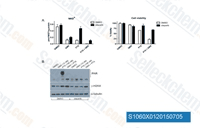
|
|
| S1208 | Doxorubicin (Adriamycin) Hydrochloride | ドキソルビチン塩酸塩 (Doxorubicin (Adriamycin, NSC 123127, DOX, Hydroxydaunorubicin) HCl) は抗生物質の一種であり、DNA トポイソメラーゼ (topoisomerase) II を阻害することで DNA 損傷を引き起こし、がん細胞中においてマイトファジー (mitophagy) およびアポトーシス (apoptosis) を誘導します。ドキソルビシンは AMPK の 基底状態におけるリン酸化を減弱します。また、ドキソルビシンは HIV 感染患者の併用療法において使用されますが、同時に HBV 再活性化のリスクを伴うことが分かっています。This product may precipitate when dissolved in PBS solution. It is recommended to prepare the stock solution in pure water and dilute with either pure water or saline to obtain the working solution. |
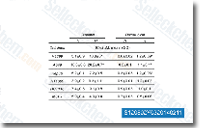
|
|
| S1076 | Adezmapimod (SB203580) | Adezmapimod (SB203580, RWJ 64809, PB 203580) is a p38 MAPK inhibitor with IC50 of 0.3-0.5 μM in THP-1 cells, 10-fold less sensitive to SAPK3(106T) and SAPK4(106T) and blocks PKB phosphorylation with IC50 of 3-5 μM. SB203580 induces mitophagy and autophagy. |
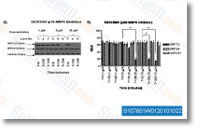
|
|
| S1102 | U0126-EtOH | U0126-EtOH is a highly selective inhibitor of MEK1/2 with IC50 of 0.07 μM/0.06 μM in cell-free assays, 100-fold higher affinity for ΔN3-S218E/S222D MEK than PD98059. U0126 inhibits autophagy and mitophagy with antiviral activity. |
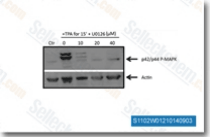
|
|
| S1378 | Ruxolitinib (INCB18424) | ルクソリチニブ (Ruxolitinib (INCB018424)) は、最初に臨床試験が行われた強力で選択的なJAK1/2 阻害剤であり、IC50 はそれぞれ 3.3 nM/ 2.8 nM、JAK1/2 に対して JAK3 の 130 倍の選択性を示します。ルクソリチニブはマイトファジー (mitophagy) によって抗腫瘍作用を示します。また、オートファジー (autophagy) を誘導し、アポトーシス (apoptosis) を促進します。 |
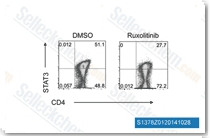
|
|
| S1002 | ABT-737 | ABT-737 is a BH3 mimetic inhibitor of Bcl-xL, Bcl-2 and Bcl-w with EC50 of 78.7 nM, 30.3 nM and 197.8 nM in cell-free assays, respectively; no inhibition observed against Mcl-1, Bcl-B or Bfl-1. ABT-737 induces mitochondrial pathway apoptosis and mitophagy. Phase 2. |
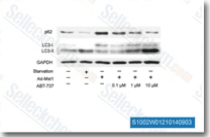
|
|
| S1225 | Etoposide | Etoposide is a semisynthetic derivative of podophyllotoxin, which inhibits DNA synthesis via topoisomerase II inhibition activity which enhances double-strand and single-strand cleavage of DNA and reversibly inhibits repair by topoisomerase II binding. Etoposide induces autophagy, mitophagy and apoptosis. |
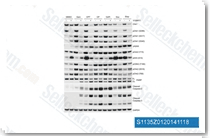
|
|
| S5243 | Ruxolitinib (INCB18424) Phosphate | Ruxolitinib Phosphate (INCB018424, INC424) is the phosphate salt form of Ruxolitinib. Ruxolitinib is the first potent, selective, JAK1/2 inhibitor to enter the clinic with IC50 of 3.3 nM/2.8 nM in cell-free assays, >130-fold selectivity for JAK1/2 versus JAK3. Ruxolitinib kills tumor cells through toxic mitophagy. Ruxolitinib induces autophagy and enhances apoptosis. | ||
| S1042 | Sunitinib malate | Sunitinib malate is a multi-targeted RTK inhibitor targeting VEGFR2 (Flk-1) and PDGFRβ with IC50 of 80 nM and 2 nM in cell-free assays, and also inhibits c-Kit. Sunitinib Malate effectively inhibits autophosphorylation of Ire1α. Sunitinib Malate increases both death receptor and mitochondrial-dependent apoptosis. |
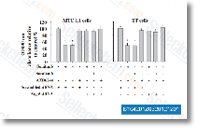
|
|
| S1802 | AICAR (Acadesine) | AICAR (Acadesine, NSC105823, AICA Riboside), an AMPK activator, results in accumulation of ZMP, which mimics the stimulating effect of AMP on AMPK and AMPK kinase. AICAR (Acadesine) induces mitophagy. Phase 3. |
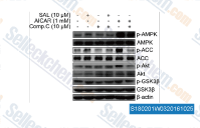
|
|
| S1141 | Tanespimycin (17-AAG) | Tanespimycin (17-AAG, CP127374, NSC-330507, KOS 953) is a potent HSP90 inhibitor with IC50 of 5 nM in a cell-free assay, having a 100-fold higher binding affinity for HSP90 derived from tumour cells than HSP90 from normal cells. Tanespimycin (17-AAG) induces apoptosis, necrosis, autophagy and mitophagy. Phase 3. |
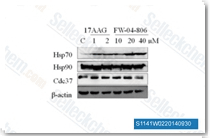
|
|
| S2218 | Torkinib (PP242) | Torkinib (PP242) is a selective mTOR inhibitor with IC50 of 8 nM in cell-free assays; targets both mTOR complexes with >10- and 100-fold selectivity for mTOR than PI3Kδ or PI3Kα/β/γ, respectively. Torkinib (PP242) induces mitophagy and apoptosis. |
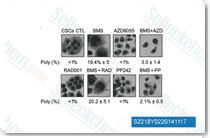
|
|
| S2730 | Crenolanib | Crenolanib is a potent and selective inhibitor of PDGFRα/β with Kd of 2.1 nM/3.2 nM in CHO cells, also potently inhibits FLT3, sensitive to D842V mutation not V561D mutation, >100-fold more selective for PDGFR than c-Kit, VEGFR-2, TIE-2, FGFR-2, EGFR, erbB2, and Src. Crenolanib helps to induce mitophagy. |
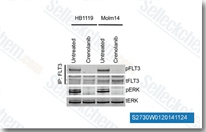
|
|
| S1322 | Dexamethasone | Dexamethasone is a potent synthetic member of the glucocorticoid class of steroid drugs, and an interleukin receptor modulator that has anti-inflammatory and immunosuppressant effects. Dexamethasone induces autophagy and mitophagy. Dexamethasone is tested in hospitalized patients with COVID-19 and is found to have benefits for critically ill patients. |
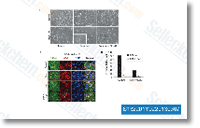
|
|
| S1950 | Metformin Hydrochloride | Metformin HCl (1,1-Dimethylbiguanide HCl) decreases hyperglycemia in hepatocytes primarily by suppressing glucose production by the liver (hepatic gluconeogenesis). Metformin promotes mitophagy in mononuclear cells. Metformin induces apoptosis of lung cancer cells through activating JNK/p38 MAPK pathway and GADD153. |
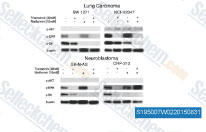
|
|
| S7162 | Mdivi-1 | Mdivi-1 (Mitochondrial division inhibitor 1) is a selective cell-permeable inhibitor of mitochondrial division DRP1 (dynamin-related GTPase) and mitochondrial division Dynamin I (Dnm1) with IC50 of 1-10 μM. Mdivi-1 attenuates mitophagy and enhances apoptosis. |
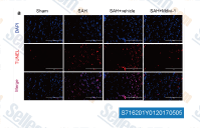
|
|
| S1396 | Resveratrol (trans-Resveratrol) | Resveratrol has a wide spectrum of targets including cyclooxygenases(i.e. COX, IC50=1.1 μM), lipooxygenases(LOX, IC50=2.7 μM), kinases, sirtuins and other proteins. It has anti-cancer, anti-inflammatory, blood-sugar-lowering and other beneficial cardiovascular effects. Resveratrol induces mitophagy/autophagy and autophagy-dependent apoptosis. |
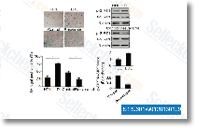
|
|
| S7046 | Brefeldin A (BFA) | Brefeldin A (BFA) is a lactone antibiotic and ATPase inhibitor for protein transport with IC50 of 0.2 μM in HCT 116 cells, induces cancer cell differentiation and apoptosis. It could also improve the HDR(homology-directed repair) efficiency and be an enhancer of CRISPR-mediated HDR. Brefeldin A is also an inhibitor of autophagy and mitophagy. |
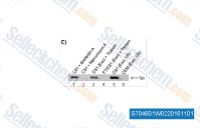
|
|
| S1792 | Simvastatin | Simvastatin is a competitive inhibitor of HMG-CoA reductase with Ki of 0.1-0.2 nM in cell-free assays. Simvastatin induces ferroptosis, mitophagy, autophagy and apoptosis. |
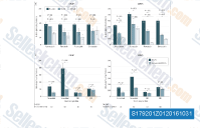
|
|
| S1168 | Valproic Acid sodium | Valproic Acid sodium is a HDAC inhibitor by selectively inducing proteasomal degradation of HDAC2, used in the treatment of epilepsy, bipolar disorder and prevention of migraine headaches. Valproic acid induces Notch1 signaling in small cell lung cancer (SCLC) cells. Valproic acid is under investigation for treatment of HIV and various cancers. Valproic acid (VPA) induces autophagy and mitophagy by upregulation of BNIP3 and mitochondrial biogenesis by upregulating PGC-1α. |
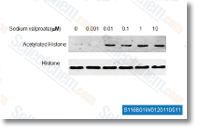
|
|
| S1204 | Melatonin | Melatonin is a MT receptor agonist, used as a dietary supplement. Melatonin is a selective ATF-6 inhibitor and downregulates COX-2. Melatonin enhances mitophagy and regulates the homeostasis of apoptosis and autophagy. |
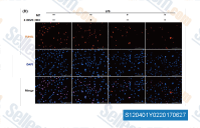
|
|
| S3944 | VPA (Valproic acid) | VPA (Valproic acid) is a fatty acid with anticonvulsant properties used in the treatment of epilepsy. It is also a histone deacetylase (HDAC) inhibitor and is under investigation for treatment of HIV and various cancers. Valproic acid (VPA) induces autophagy and mitophagy by upregulation of BNIP3 and mitochondrial biogenesis by upregulating PGC-1α. Valproic acid activates Notch-1 signaling. | ||
| S3017 | Aspirin | Aspirin (NSC 27223, Acetylsalicylic acid, ASA) is a salicylate, and irreversible COX1 and COX2 inhibitor, used as an analgesic to relieve minor aches and pains, as an antipyretic to reduce fever, and as an anti-inflammatory medication. Aspirin induces autophagy and stimulates mitophagy. | ||
| S1290 | Celastrol | Celastrol is a potent proteasome inhibitor for the chymotrypsin-like activity of a purified 20S proteasome with IC50 of 2.5 μM. Celastrol induces apoptosis and autophagy via the ROS/JNK signaling pathway. Celastrol inhibits dopaminergic neuronal death of Parkinson's disease through activating mitophagy. |
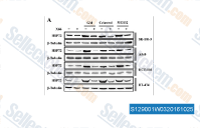
|
|
| S1759 | Pitavastatin calcium | Pitavastatin calcium, a novel member of the medication class of statins, is a calcium salt formulation of pitavastatin which is a highly effective HMG-CoA reductase inhibitor. Pitavastatin Calcium attenuates AGEs-induced mitophagy via inhibition of ROS generation. Pitavastatin Calcium induces autophagy and apoptosis. |
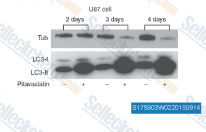
|
|
| S1351 | Ivermectin | Ivermectin is a glutamate-gated chloride channel (GluCls) activator, used as a broad-spectrum antiparasitic drug. Ivermectin (MK-933, IVM) is a specific positive allosteric effector of P2X4 and α7 nicotinic acetylcholine receptors (nAChRs). Ivermectin (MK-933) is a specific inhibitor of Impα/β1-mediated nuclear import and has potent antiviral activity towards both HIV-1 and dengue virus. Ivermectin induces autophagy through the AKT/mTOR signaling pathway and mitophagy. | ||
| S5312 | Urolithin A | Urolithin A (3,8-Dihydroxy Urolithin, 2',7-Dihydroxy-3,4-benzocoumarin), a metabolite of ellagitannin, is a first-in-class natural compound that induces mitophagy both in vitro and in vivo following oral consumption. | ||
| S2396 | Salidroside | Salidroside (Rhodioloside), a phenylpropanoid glycoside isolated from Rhodiola rosea, has been reported to have a broad spectrum of pharmacological properties. | ||
| S0881 | Mitochonic acid 5 (MA-5) | Mitochonic acid 5 (MA-5) reduces mitochondrial apoptosis via upregulation of mitophagy. Mitochonic acid 5 regulates mitophagy via Bnip3 through the MAPK-ERK-Yap signaling pathway. Mitochonic acid 5 modulates mitochondrial ATP synthesis. | ||
| E2988 | Sulfosuccinimidyl oleate sodium | Sulfosuccinimidyl oleate sodium (Sulfo-N-succinimidyl oleate sodium) is a long chain fatty acid that inhibits fatty acid transport into cells. Sulfosuccinimidyl oleate sodium is a potent and irreversible inhibitor of mitochondrial respiratory chain with IC50 of 4 μM. It inhibits CD36 mediated LCFA transport. It exhibits anti-inflammatory effect. | ||
| S2391 | Quercetin (Sophoretin) | Quercetin, a natural flavonoid present in vegetables, fruit and wine, is a stimulator of recombinant SIRT1 and also a PI3K inhibitor with IC50 of 2.4-5.4 μM. Quercetin induces mitophagy, apoptosis and protective autophagy. Phase 4. |
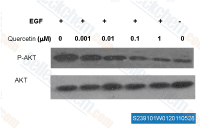
|
|
| S5958 | Metformin | Metformin (1,1-Dimethylbiguanide), a widely used drug for treatment of type 2 diabetes, activates AMP-activated protein kinase (AMPK) in hepatocytes. Metformin promotes mitophagy in mononuclear cells. Metformin induces apoptosis of lung cancer cells through activating JNK/p38 MAPK pathway and GADD153. | ||
| S9424 | Liensinine diperchlorate | Liensinine, a major isoquinoline alkaloid, inhibits late-stage autophagy/mitophagy through blocking autophagosome-lysosome fusion. It is a novel autophagy/mitophagy inhibitor. | ||
| S2348 | Rotenone | Rotenone is a botanical insecticide that is an inhibitor of mitochondrial electron transport. Rotenone inhibits NADH/DB oxidoreductase and NADH oxidase with IC50 of 28.8 nM and 5.1 nM, respectively. Rotenone induces apoptosis through enhancing mitochondrial reactive oxygen species production.Rotenone can be used to induce animal models of Parkinson's Disease. | ||
| E1462 | P62-mediated mitophagy inducer | P62-mediated mitophagy inducer (PMI) is a P62-mediated activator of mitophagy that functions independently of parkin recruitment or mitochondrial membrane potential (ΔΨm) collapse. It remains effective even in cells lacking a fully functional PINK1/Parkin pathway. PMI stabilizes Nrf2 and enhances p62 expression, thereby activating mitophagy. | ||
| S1102 | U0126-EtOH | U0126-EtOH is a highly selective inhibitor of MEK1/2 with IC50 of 0.07 μM/0.06 μM in cell-free assays, 100-fold higher affinity for ΔN3-S218E/S222D MEK than PD98059. U0126 inhibits autophagy and mitophagy with antiviral activity. |

|
|
| S7162 | Mdivi-1 | Mdivi-1 (Mitochondrial division inhibitor 1) is a selective cell-permeable inhibitor of mitochondrial division DRP1 (dynamin-related GTPase) and mitochondrial division Dynamin I (Dnm1) with IC50 of 1-10 μM. Mdivi-1 attenuates mitophagy and enhances apoptosis. |

|
|
| S7046 | Brefeldin A (BFA) | Brefeldin A (BFA) is a lactone antibiotic and ATPase inhibitor for protein transport with IC50 of 0.2 μM in HCT 116 cells, induces cancer cell differentiation and apoptosis. It could also improve the HDR(homology-directed repair) efficiency and be an enhancer of CRISPR-mediated HDR. Brefeldin A is also an inhibitor of autophagy and mitophagy. |

|
|
| S1759 | Pitavastatin calcium | Pitavastatin calcium, a novel member of the medication class of statins, is a calcium salt formulation of pitavastatin which is a highly effective HMG-CoA reductase inhibitor. Pitavastatin Calcium attenuates AGEs-induced mitophagy via inhibition of ROS generation. Pitavastatin Calcium induces autophagy and apoptosis. |

|
|
| E2988 | Sulfosuccinimidyl oleate sodium | Sulfosuccinimidyl oleate sodium (Sulfo-N-succinimidyl oleate sodium) is a long chain fatty acid that inhibits fatty acid transport into cells. Sulfosuccinimidyl oleate sodium is a potent and irreversible inhibitor of mitochondrial respiratory chain with IC50 of 4 μM. It inhibits CD36 mediated LCFA transport. It exhibits anti-inflammatory effect. | ||
| S9424 | Liensinine diperchlorate | Liensinine, a major isoquinoline alkaloid, inhibits late-stage autophagy/mitophagy through blocking autophagosome-lysosome fusion. It is a novel autophagy/mitophagy inhibitor. | ||
| S1060 | Olaparib (AZD2281) | オラパリブ (Olaparib (AZD2281, KU0059436)) は選択的 PARP1/2 阻害剤であり、cell-free assay における IC50 はそれぞれ 5 nM および 1 nM です。タンキラーゼ-1 (Tankyrase-1) に対しては 1/300 の効果を示します。オラパリブは BRCA に変異をきたした細胞において、マイトファジー (mitophagy) に関連した顕著なオートファジー (mitophagy) を誘発します。 |

|
|
| S1208 | Doxorubicin (Adriamycin) Hydrochloride | ドキソルビチン塩酸塩 (Doxorubicin (Adriamycin, NSC 123127, DOX, Hydroxydaunorubicin) HCl) は抗生物質の一種であり、DNA トポイソメラーゼ (topoisomerase) II を阻害することで DNA 損傷を引き起こし、がん細胞中においてマイトファジー (mitophagy) およびアポトーシス (apoptosis) を誘導します。ドキソルビシンは AMPK の 基底状態におけるリン酸化を減弱します。また、ドキソルビシンは HIV 感染患者の併用療法において使用されますが、同時に HBV 再活性化のリスクを伴うことが分かっています。This product may precipitate when dissolved in PBS solution. It is recommended to prepare the stock solution in pure water and dilute with either pure water or saline to obtain the working solution. |

|
|
| S1076 | Adezmapimod (SB203580) | Adezmapimod (SB203580, RWJ 64809, PB 203580) is a p38 MAPK inhibitor with IC50 of 0.3-0.5 μM in THP-1 cells, 10-fold less sensitive to SAPK3(106T) and SAPK4(106T) and blocks PKB phosphorylation with IC50 of 3-5 μM. SB203580 induces mitophagy and autophagy. |

|
|
| S1378 | Ruxolitinib (INCB18424) | ルクソリチニブ (Ruxolitinib (INCB018424)) は、最初に臨床試験が行われた強力で選択的なJAK1/2 阻害剤であり、IC50 はそれぞれ 3.3 nM/ 2.8 nM、JAK1/2 に対して JAK3 の 130 倍の選択性を示します。ルクソリチニブはマイトファジー (mitophagy) によって抗腫瘍作用を示します。また、オートファジー (autophagy) を誘導し、アポトーシス (apoptosis) を促進します。 |

|
|
| S1002 | ABT-737 | ABT-737 is a BH3 mimetic inhibitor of Bcl-xL, Bcl-2 and Bcl-w with EC50 of 78.7 nM, 30.3 nM and 197.8 nM in cell-free assays, respectively; no inhibition observed against Mcl-1, Bcl-B or Bfl-1. ABT-737 induces mitochondrial pathway apoptosis and mitophagy. Phase 2. |

|
|
| S1225 | Etoposide | Etoposide is a semisynthetic derivative of podophyllotoxin, which inhibits DNA synthesis via topoisomerase II inhibition activity which enhances double-strand and single-strand cleavage of DNA and reversibly inhibits repair by topoisomerase II binding. Etoposide induces autophagy, mitophagy and apoptosis. |

|
|
| S5243 | Ruxolitinib (INCB18424) Phosphate | Ruxolitinib Phosphate (INCB018424, INC424) is the phosphate salt form of Ruxolitinib. Ruxolitinib is the first potent, selective, JAK1/2 inhibitor to enter the clinic with IC50 of 3.3 nM/2.8 nM in cell-free assays, >130-fold selectivity for JAK1/2 versus JAK3. Ruxolitinib kills tumor cells through toxic mitophagy. Ruxolitinib induces autophagy and enhances apoptosis. | ||
| S1042 | Sunitinib malate | Sunitinib malate is a multi-targeted RTK inhibitor targeting VEGFR2 (Flk-1) and PDGFRβ with IC50 of 80 nM and 2 nM in cell-free assays, and also inhibits c-Kit. Sunitinib Malate effectively inhibits autophosphorylation of Ire1α. Sunitinib Malate increases both death receptor and mitochondrial-dependent apoptosis. |

|
|
| S1802 | AICAR (Acadesine) | AICAR (Acadesine, NSC105823, AICA Riboside), an AMPK activator, results in accumulation of ZMP, which mimics the stimulating effect of AMP on AMPK and AMPK kinase. AICAR (Acadesine) induces mitophagy. Phase 3. |

|
|
| S1141 | Tanespimycin (17-AAG) | Tanespimycin (17-AAG, CP127374, NSC-330507, KOS 953) is a potent HSP90 inhibitor with IC50 of 5 nM in a cell-free assay, having a 100-fold higher binding affinity for HSP90 derived from tumour cells than HSP90 from normal cells. Tanespimycin (17-AAG) induces apoptosis, necrosis, autophagy and mitophagy. Phase 3. |

|
|
| S2218 | Torkinib (PP242) | Torkinib (PP242) is a selective mTOR inhibitor with IC50 of 8 nM in cell-free assays; targets both mTOR complexes with >10- and 100-fold selectivity for mTOR than PI3Kδ or PI3Kα/β/γ, respectively. Torkinib (PP242) induces mitophagy and apoptosis. |

|
|
| S2730 | Crenolanib | Crenolanib is a potent and selective inhibitor of PDGFRα/β with Kd of 2.1 nM/3.2 nM in CHO cells, also potently inhibits FLT3, sensitive to D842V mutation not V561D mutation, >100-fold more selective for PDGFR than c-Kit, VEGFR-2, TIE-2, FGFR-2, EGFR, erbB2, and Src. Crenolanib helps to induce mitophagy. |

|
|
| S1322 | Dexamethasone | Dexamethasone is a potent synthetic member of the glucocorticoid class of steroid drugs, and an interleukin receptor modulator that has anti-inflammatory and immunosuppressant effects. Dexamethasone induces autophagy and mitophagy. Dexamethasone is tested in hospitalized patients with COVID-19 and is found to have benefits for critically ill patients. |

|
|
| S1950 | Metformin Hydrochloride | Metformin HCl (1,1-Dimethylbiguanide HCl) decreases hyperglycemia in hepatocytes primarily by suppressing glucose production by the liver (hepatic gluconeogenesis). Metformin promotes mitophagy in mononuclear cells. Metformin induces apoptosis of lung cancer cells through activating JNK/p38 MAPK pathway and GADD153. |

|
|
| S1396 | Resveratrol (trans-Resveratrol) | Resveratrol has a wide spectrum of targets including cyclooxygenases(i.e. COX, IC50=1.1 μM), lipooxygenases(LOX, IC50=2.7 μM), kinases, sirtuins and other proteins. It has anti-cancer, anti-inflammatory, blood-sugar-lowering and other beneficial cardiovascular effects. Resveratrol induces mitophagy/autophagy and autophagy-dependent apoptosis. |

|
|
| S1792 | Simvastatin | Simvastatin is a competitive inhibitor of HMG-CoA reductase with Ki of 0.1-0.2 nM in cell-free assays. Simvastatin induces ferroptosis, mitophagy, autophagy and apoptosis. |

|
|
| S1168 | Valproic Acid sodium | Valproic Acid sodium is a HDAC inhibitor by selectively inducing proteasomal degradation of HDAC2, used in the treatment of epilepsy, bipolar disorder and prevention of migraine headaches. Valproic acid induces Notch1 signaling in small cell lung cancer (SCLC) cells. Valproic acid is under investigation for treatment of HIV and various cancers. Valproic acid (VPA) induces autophagy and mitophagy by upregulation of BNIP3 and mitochondrial biogenesis by upregulating PGC-1α. |

|
|
| S1204 | Melatonin | Melatonin is a MT receptor agonist, used as a dietary supplement. Melatonin is a selective ATF-6 inhibitor and downregulates COX-2. Melatonin enhances mitophagy and regulates the homeostasis of apoptosis and autophagy. |

|
|
| S3944 | VPA (Valproic acid) | VPA (Valproic acid) is a fatty acid with anticonvulsant properties used in the treatment of epilepsy. It is also a histone deacetylase (HDAC) inhibitor and is under investigation for treatment of HIV and various cancers. Valproic acid (VPA) induces autophagy and mitophagy by upregulation of BNIP3 and mitochondrial biogenesis by upregulating PGC-1α. Valproic acid activates Notch-1 signaling. | ||
| S3017 | Aspirin | Aspirin (NSC 27223, Acetylsalicylic acid, ASA) is a salicylate, and irreversible COX1 and COX2 inhibitor, used as an analgesic to relieve minor aches and pains, as an antipyretic to reduce fever, and as an anti-inflammatory medication. Aspirin induces autophagy and stimulates mitophagy. | ||
| S1290 | Celastrol | Celastrol is a potent proteasome inhibitor for the chymotrypsin-like activity of a purified 20S proteasome with IC50 of 2.5 μM. Celastrol induces apoptosis and autophagy via the ROS/JNK signaling pathway. Celastrol inhibits dopaminergic neuronal death of Parkinson's disease through activating mitophagy. |

|
|
| S1351 | Ivermectin | Ivermectin is a glutamate-gated chloride channel (GluCls) activator, used as a broad-spectrum antiparasitic drug. Ivermectin (MK-933, IVM) is a specific positive allosteric effector of P2X4 and α7 nicotinic acetylcholine receptors (nAChRs). Ivermectin (MK-933) is a specific inhibitor of Impα/β1-mediated nuclear import and has potent antiviral activity towards both HIV-1 and dengue virus. Ivermectin induces autophagy through the AKT/mTOR signaling pathway and mitophagy. | ||
| S5312 | Urolithin A | Urolithin A (3,8-Dihydroxy Urolithin, 2',7-Dihydroxy-3,4-benzocoumarin), a metabolite of ellagitannin, is a first-in-class natural compound that induces mitophagy both in vitro and in vivo following oral consumption. | ||
| S0881 | Mitochonic acid 5 (MA-5) | Mitochonic acid 5 (MA-5) reduces mitochondrial apoptosis via upregulation of mitophagy. Mitochonic acid 5 regulates mitophagy via Bnip3 through the MAPK-ERK-Yap signaling pathway. Mitochonic acid 5 modulates mitochondrial ATP synthesis. | ||
| S2391 | Quercetin (Sophoretin) | Quercetin, a natural flavonoid present in vegetables, fruit and wine, is a stimulator of recombinant SIRT1 and also a PI3K inhibitor with IC50 of 2.4-5.4 μM. Quercetin induces mitophagy, apoptosis and protective autophagy. Phase 4. |

|
|
| S5958 | Metformin | Metformin (1,1-Dimethylbiguanide), a widely used drug for treatment of type 2 diabetes, activates AMP-activated protein kinase (AMPK) in hepatocytes. Metformin promotes mitophagy in mononuclear cells. Metformin induces apoptosis of lung cancer cells through activating JNK/p38 MAPK pathway and GADD153. | ||
| S2348 | Rotenone | Rotenone is a botanical insecticide that is an inhibitor of mitochondrial electron transport. Rotenone inhibits NADH/DB oxidoreductase and NADH oxidase with IC50 of 28.8 nM and 5.1 nM, respectively. Rotenone induces apoptosis through enhancing mitochondrial reactive oxygen species production.Rotenone can be used to induce animal models of Parkinson's Disease. | ||
| E1462 | P62-mediated mitophagy inducer | P62-mediated mitophagy inducer (PMI) is a P62-mediated activator of mitophagy that functions independently of parkin recruitment or mitochondrial membrane potential (ΔΨm) collapse. It remains effective even in cells lacking a fully functional PINK1/Parkin pathway. PMI stabilizes Nrf2 and enhances p62 expression, thereby activating mitophagy. | ||
| S2396 | Salidroside | Salidroside (Rhodioloside), a phenylpropanoid glycoside isolated from Rhodiola rosea, has been reported to have a broad spectrum of pharmacological properties. |
